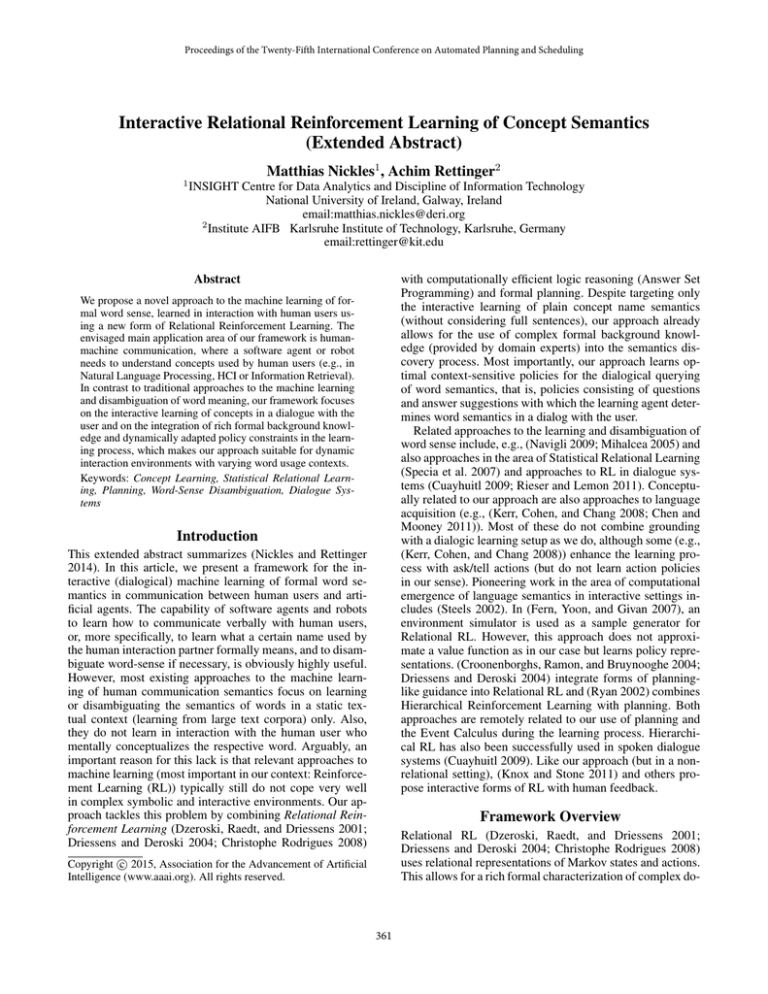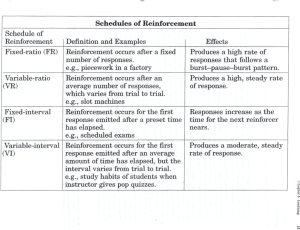
Proceedings of the Twenty-Fifth International Conference on Automated Planning and Scheduling
Interactive Relational Reinforcement Learning of Concept Semantics
(Extended Abstract)
Matthias Nickles1 , Achim Rettinger2
1
INSIGHT Centre for Data Analytics and Discipline of Information Technology
National University of Ireland, Galway, Ireland
email:matthias.nickles@deri.org
2
Institute AIFB Karlsruhe Institute of Technology, Karlsruhe, Germany
email:rettinger@kit.edu
Abstract
with computationally efficient logic reasoning (Answer Set
Programming) and formal planning. Despite targeting only
the interactive learning of plain concept name semantics
(without considering full sentences), our approach already
allows for the use of complex formal background knowledge (provided by domain experts) into the semantics discovery process. Most importantly, our approach learns optimal context-sensitive policies for the dialogical querying
of word semantics, that is, policies consisting of questions
and answer suggestions with which the learning agent determines word semantics in a dialog with the user.
Related approaches to the learning and disambiguation of
word sense include, e.g., (Navigli 2009; Mihalcea 2005) and
also approaches in the area of Statistical Relational Learning
(Specia et al. 2007) and approaches to RL in dialogue systems (Cuayhuitl 2009; Rieser and Lemon 2011). Conceptually related to our approach are also approaches to language
acquisition (e.g., (Kerr, Cohen, and Chang 2008; Chen and
Mooney 2011)). Most of these do not combine grounding
with a dialogic learning setup as we do, although some (e.g.,
(Kerr, Cohen, and Chang 2008)) enhance the learning process with ask/tell actions (but do not learn action policies
in our sense). Pioneering work in the area of computational
emergence of language semantics in interactive settings includes (Steels 2002). In (Fern, Yoon, and Givan 2007), an
environment simulator is used as a sample generator for
Relational RL. However, this approach does not approximate a value function as in our case but learns policy representations. (Croonenborghs, Ramon, and Bruynooghe 2004;
Driessens and Deroski 2004) integrate forms of planninglike guidance into Relational RL and (Ryan 2002) combines
Hierarchical Reinforcement Learning with planning. Both
approaches are remotely related to our use of planning and
the Event Calculus during the learning process. Hierarchical RL has also been successfully used in spoken dialogue
systems (Cuayhuitl 2009). Like our approach (but in a nonrelational setting), (Knox and Stone 2011) and others propose interactive forms of RL with human feedback.
We propose a novel approach to the machine learning of formal word sense, learned in interaction with human users using a new form of Relational Reinforcement Learning. The
envisaged main application area of our framework is humanmachine communication, where a software agent or robot
needs to understand concepts used by human users (e.g., in
Natural Language Processing, HCI or Information Retrieval).
In contrast to traditional approaches to the machine learning
and disambiguation of word meaning, our framework focuses
on the interactive learning of concepts in a dialogue with the
user and on the integration of rich formal background knowledge and dynamically adapted policy constraints in the learning process, which makes our approach suitable for dynamic
interaction environments with varying word usage contexts.
Keywords: Concept Learning, Statistical Relational Learning, Planning, Word-Sense Disambiguation, Dialogue Systems
Introduction
This extended abstract summarizes (Nickles and Rettinger
2014). In this article, we present a framework for the interactive (dialogical) machine learning of formal word semantics in communication between human users and artificial agents. The capability of software agents and robots
to learn how to communicate verbally with human users,
or, more specifically, to learn what a certain name used by
the human interaction partner formally means, and to disambiguate word-sense if necessary, is obviously highly useful.
However, most existing approaches to the machine learning of human communication semantics focus on learning
or disambiguating the semantics of words in a static textual context (learning from large text corpora) only. Also,
they do not learn in interaction with the human user who
mentally conceptualizes the respective word. Arguably, an
important reason for this lack is that relevant approaches to
machine learning (most important in our context: Reinforcement Learning (RL)) typically still do not cope very well
in complex symbolic and interactive environments. Our approach tackles this problem by combining Relational Reinforcement Learning (Dzeroski, Raedt, and Driessens 2001;
Driessens and Deroski 2004; Christophe Rodrigues 2008)
Framework Overview
Relational RL (Dzeroski, Raedt, and Driessens 2001;
Driessens and Deroski 2004; Christophe Rodrigues 2008)
uses relational representations of Markov states and actions.
This allows for a rich formal characterization of complex do-
c 2015, Association for the Advancement of Artificial
Copyright Intelligence (www.aaai.org). All rights reserved.
361
for Spoken Dialogue Systems. Ph.D. Dissertation, School of
Informatics, University of Edinburgh.
Driessens, K., and Deroski, S. 2004. Integrating guidance
into relational reinforcement learning. Machine Learning
57(3):271–304.
Dzeroski, S.; Raedt, L. D.; and Driessens, K. 2001. Relational reinforcement learning. Machine Learning 43(1/2):7–
52.
Fern, A.; Yoon, S.; and Givan, R. 2007. Reinforcement
learning in relational domains: A policy-language approach.
In L. Getoor, B. T., ed., Introduction to Statistical Relational
Learning. MIT Press.
Kerr, W.; Cohen, P.; and Chang, Y. H. 2008. Learning and
playing in wubble world. In Artificial Intelligence and Interactive Digital Entertainment (AIIDE).
Kim, T.-W.; Lee, J.; and Palla, R. 2009. Circumscriptive
event calculus as answer set programming. In Boutilier, C.,
ed., IJCAI, 823–829.
Knox, W. B., and Stone, P. 2011. Augmenting reinforcement learning with human feedback. In Procs. ICML 2011
Workshop on New Developments in Imitation Learning.
Mihalcea, R. 2005. Unsupervised large-vocabulary word
sense disambiguation with graph-based algorithms for sequence data labeling. In Proceedings of the Conference
on Human Language Technology and Empirical Methods in
Natural Language Processing, HLT ’05, 411–418. Stroudsburg, PA, USA: Association for Computational Linguistics.
Navigli, R. 2009. Word sense disambiguation: A survey.
ACM Comput. Surv. 41(2):10:1–10:69.
Nickles, M., and Rettinger, A. 2014. Interactive relational reinforcement learning of concept semantics. Machine Learning 94(2):169–204.
Rieser, V., and Lemon, O. 2011. Reinforcement learning
for adaptive dialogue systems: a data-driven methodology
for dialogue management and natural language generation.
Springer.
Ryan, M. R. K. 2002. Hierarchical Reinforcement Learning: A Hybrid Approach. Ph.D. Dissertation.
Specia, L.; Stevenson, M.; Graas, M.; and Nunes, V. 2007.
Learning expressive models for words sense disambiguation. In In Proceedings of the 45th Annual Meeting of the
Association for Computational Linguistics (ACL, 41–48.
Steels, L. 2002. Grounding Symbols through Evolutionary
Language Games. In Cangelosi, A., and Parisi, D., eds., Simulating the Evolution of Language. London: Springer. chapter 10, 211–226.
mains (like in NLP) whose structural properties would otherwise be inaccessible to RL. Our framework differs from
existing approaches in this field mainly by its human-agent
interaction component and by the use of an efficient logical reasoning approach, namely Answer Set Programming
(ASP) with a variant of the Event Calculus (EC) (Kim, Lee,
and Palla 2009). The basic learning algorithm is a variant of Relational Q-Learning (Christophe Rodrigues 2008;
Driessens and Deroski 2004). Besides the general benefit of
Relational RL (i.e., the ability to represent and learn in structurally complex domains), the main advantage of this hybrid
approach is that it seamlessly integrates logical reasoning
and RL for the modeling of logical constraints, goals, context and effects for/of agent and human actions.
The agent’s goal is to discover the formal meaning of
words, as conceptualized by the human user. In each relational reinforcement learning episode, the agent presents the
user a proposal for the meaning of the unknown/ambiguous
word and asks the user questions until the correct formal
meaning has been found. Possible questions and answers
are constrained by the reasoner (ASP solver) and dynamically adapted during interaction with the user. The agent
receives rewards depending on the answer (essentially, the
user awards the agent). The overall learning goals are to
learn the right questions in the right sequence (generalized
over multiple episodes) and of course also to learn the formal meaning of each individual concept.
Our approach is closely related to planning. The learning agent generates policy constraints and planning subgoals
from interactions with the human user. The ASP solver ensures that at the end of a learning episode, these sub-goals
are reached (if possible), by constraining the set of feasible
action policies. If this does not already discover an optimal
action sequence, reinforcement learning finds the optimal
policy among candidate policies. As a further contribution,
we introduce so-called “profiles” which allow the algorithm
to adapt on-line to different interaction partners. This way,
we can deal with moving learning targets in form of multiple
different interaction partners.
Our experimental evaluation (using simulations of human
users) shows that our rather general approach successfully
works in combinatorially challenging domains, i.e., that
it learns optimal interaction policies (including in a nonstationary domain), and that it requires only a relatively low
number of learning episodes to do so.
References
Chen, D. L., and Mooney, R. J. 2011. Mooney: Panning for
gold: Finding relevant semantic content for grounded language learning. In In Procs. MLSLP.
Christophe Rodrigues, Pierre Gerard, C. R. 2008. Relational
td reinforcement learning. In EWRL’08.
Croonenborghs, T.; Ramon, J.; and Bruynooghe, M. 2004.
Towards informed reinforcement learning. In Proceedings
of the ICML2004 Workshop on Relational Reinforcement
Learning, 21–26.
Cuayhuitl, H. 2009. Hierarchical Reinforcement Learning
362









